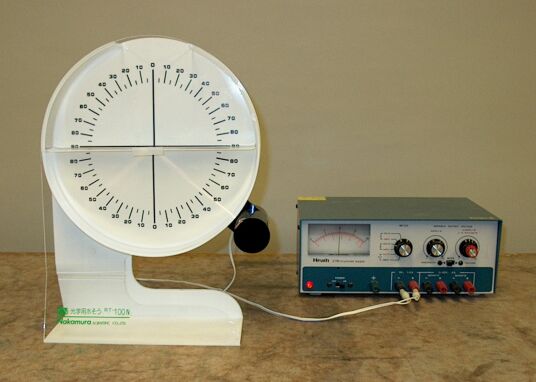

The black cylinder near the 50-degree mark on the apparatus in the photograph above holds a lamp, for which the 5-volt supply at right provides power. A long slit in front of the lamp constrains the light coming from the lamp to a narrow ribbon shining along a radius of the circle of the tank, which is half-filled with water. The arm that supports the lamp is mounted to the center of the rear of the tank, and you can adjust the angle of the light beam, with respect to the surface of the water, by rotating the arm. (Do not move the lamp by the housing, because in doing so you could move the slit, skewing the beam off the radius.) As is clear from the photograph, you can see the beam reflected from the back of the tank. By directing the beam from above or below the surface of the water, you can show what happens when light travels, respectively, from one medium (air) to another that has a higher index of refraction (water), and vice versa. (The incident, reflected and refracted light beams are easier to see if you darken the room.)
When light, whose speed in a vacuum is 2.998 × 108 m/s, passes through a medium, it slows because of its interaction with that medium. How much it slows depends on how dense the medium is. We can use Huygens’ principle to construct a wave passing from one medium to a different medium (see the explanation for 80.09 – Hinged plane mirrors). If we make v1t the distance the wave travels in the first medium during the time interval t, and v2t the distance it travels in the second medium, we find that sin θ1/sin θ2 = v1/v2, where θ1 and θ2 are the angles of the paths of the incident light and the refracted light, respectively, both with reference to the normal to the interface between the two media.
The index of refraction of a medium is defined as the ratio of the speed of light in vacuum to that in the medium, or n = c/v. From this, we see that v1/v2 = n2/n1, and, rearranging the above equation, that n1 sin θ1 = n2 sin θ2. This equation is known as Snell’s law, after Willebrod Snell. (In France, it is called Descartes’ law.) The speed of light in air (at 1 atm and 20°C) is so close to that in vacuum, that the index of refraction of air is 1.0003. So for transitions between air and other media, unless a particular problem requires extremely high precision, you can usually take the index of refraction of air as equal to 1. Typically, the index of refraction varies with wavelength, so you can use refraction to separate the components of a beam that comprises light of several wavelengths. (See demonstration 80.21 – Dispersion of white light.)
When a ray of light travels from one medium into another that has a different index of refraction, some portion of the light is reflected at an equal and opposite angle to the angle of incidence. Most of the light continues into the second medium, but, except if the angle of incidence is zero, it cannot continue in its original direction, but is bent, or refracted, as it passes into the second medium. From Snell’s law, we can see that if the light passes from one medium to a denser medium, it is bent towards the normal (n2/n1 > 1, so sin θ1/sin θ2 > 1, and θ2 < θ1). For all angles of incidence from zero to just below 90°, then, there is always a reflected ray and a refracted ray. This is the case when you rotate the lamp housing to any position above the surface of the water, so that the light goes from the air to the water.
If the light passes from one medium to another that has a lower index of refraction, n2/n1 is now less than one, so θ2 is now greater than θ1, and upon entering the second medium, the light is bent away from the normal. If you begin with the lamp housing below the refraction tank, as you move up from zero angle of incidence, the angle of the refracted ray increases, until at a particular angle of incidence, the critical angle, the angle of refraction equals 90°, and the refracted ray lies parallel to the surface of the water. Above this angle, there can be no refracted ray; there is only a reflected ray. The light suffers total internal reflection. The angle at which this happens for the water-air interface is θ1 = sin-1 (1/1.33) = 48.8° (approximately where the lamp is set in the photograph above). This phenomenon is quite useful. For example, it allows one to use right-angle prisms to steer light beams in optical systems, and it is what allows fiber optics to carry optical signals over long distances (see demonstration 80.30 – Laser to Plexiglas® spiral and fiber optics).
References:
1) Halliday, David and Resnick, Robert. Physics, Part Two, Third Edition (New York: John Wiley and Sons, 1977), pp. 938-940, 943-949.
2) Sears, Francis Weston and Zemansky, Mark W. College Physics, Third Edition (Reading, Massachusetts: Addison-Wesley Publishing Company, Inc., 1960), pp. 790-796.